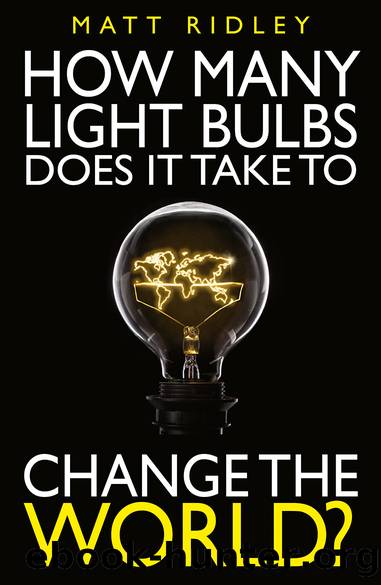How Many Light Bulbs Does It Take to Change the World? by Ridley Matt;Davies Stephen;

Author:Ridley, Matt;Davies, Stephen;
Language: eng
Format: epub
Publisher: London Publishing Partnership
Published: 2019-11-22T12:48:27+00:00
The Hayek Lectureâs main arguments
The Hayek Lecture sets out several arguments. The central one is that innovation is the product not of heroic visionaries or outstanding and rare individuals, but of large numbers of ordinary, enquiring and enterprising people and the interactions between them. Thus, it rejects the idea Ayn Rand expressed in The Fountainhead: that progress and innovation come from Promethean individuals, with the rest of humanity eventually following them and benefitting from their creativity. Instead, innovation is a social phenomenon, with any particular innovation having many parents and originators, most of them forgotten or even unknown. What matters is the social framework of trade and the free exchange of both goods and ideas among people. Ridley powerfully makes the point that where trade, exchange and contact with the rest of the world are reduced or absent, innovation tends not to happen and regression can actually take place. The classic historical example of this is the fate of Western Europe in the aftermath of the collapse of the West Roman Empire and the disruption of Mediterranean sea routes by the Arab conquests. As Bryan Ward-Perkins (2006) has shown, the result was a decline in trade, a disastrous reduction in wealth and production and the systematic loss of a whole range of technologies (one of which, Roman concrete, has only just been rediscovered4).
Ridleyâs second argument, which follows from this, is that innovation and creativity are the product of voluntary human interaction. This means that it is futile and even counterproductive to try and plan it or encourage it by deliberate political action â a point Terence Kealey (1996) has made very powerfully. It also means that restraining human interaction and exchange will hamper or even prevent innovation. As he points out, the difficult thing in the process of innovation is not so much the generation of the original idea or vision (though that is difficult enough) but the conversion of the vision into a useful and practical innovation that brings about an increase in wealth and human well-being. It is that process of tinkering, experimentation and marginal improvement that requires the free interaction of millions of people and the unhindered exchange of not just ideas, but products, goods and services.
The way in which this brings about innovation and creativity can be seen very clearly in fields such as music and cuisine. Here, interaction and trade between people lead to experimentation and the development of new kinds of cuisine and forms of music. An important aspect of this is the appearance of cultural hybrids that combine knowledge and insight from different cultures and parts of the world. For example, the Indian cuisine that most British people are familiar with is actually Mughlai cooking, the cuisine of the Mughals, which combined indigenous Indian techniques and ingredients with others drawn from the Mughalsâ original homeland of Central Asia (the use of yoghurt for example) and yet others brought to India by Arab traders and the Portuguese (such as the potato, the tomato and the chilli pepper).
Download
This site does not store any files on its server. We only index and link to content provided by other sites. Please contact the content providers to delete copyright contents if any and email us, we'll remove relevant links or contents immediately.
Bad Blood by John Carreyrou(5782)
Principles: Life and Work by Ray Dalio(5335)
Rich Dad Poor Dad by Robert T. Kiyosaki(5167)
Management Strategies for the Cloud Revolution: How Cloud Computing Is Transforming Business and Why You Can't Afford to Be Left Behind by Charles Babcock(4135)
The Confidence Code by Katty Kay(3576)
Thinking in Bets by Annie Duke(3540)
Playing to Win_ How Strategy Really Works by A.G. Lafley & Roger L. Martin(3023)
American Kingpin by Nick Bilton(2983)
Delivering Happiness by Tony Hsieh(2926)
Project Animal Farm: An Accidental Journey into the Secret World of Farming and the Truth About Our Food by Sonia Faruqi(2667)
Brotopia by Emily Chang(2594)
I Live in the Future & Here's How It Works by Nick Bilton(2532)
Mastering Bitcoin: Programming the Open Blockchain by Andreas M. Antonopoulos(2518)
The Power of Habit by Charles Duhigg(2497)
The Content Trap by Bharat Anand(2496)
The Marketing Plan Handbook: Develop Big-Picture Marketing Plans for Pennies on the Dollar by Robert W. Bly(2421)
The Tyranny of Metrics by Jerry Z. Muller(2407)
Building a StoryBrand by Donald Miller(2368)
Applied Empathy by Michael Ventura(2334)
